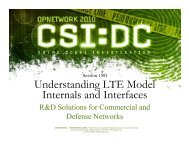Automated Axon Tracking of 3D Confocal Laser Scanning ...
Automated Axon Tracking of 3D Confocal Laser Scanning ...
Automated Axon Tracking of 3D Confocal Laser Scanning ...
Create successful ePaper yourself
Turn your PDF publications into a flip-book with our unique Google optimized e-Paper software.
(a)(b)(c)Figure 7 - Segmentation <strong>of</strong> axons using watershed: (a) Original Image, (b) Segmentation without imposition <strong>of</strong>seeds, and (c) Segmentation using watershed after imposition <strong>of</strong> seeds. The scale bar in (a) corresponds to 1μm.The traditional watershed algorithm does not use a priori information during segmentation.Because it is based only on intensity values in the image, it fails to segment close-lying or closeoveraxon cross-sections with a large difference in intensities. One approach to address this issuemakes use <strong>of</strong> seed regions rather than seed points. Figure 9(b) shows the seed regions initializedto an ellipse whose major and minor axis are set to half their values determined in the previousslice, centered at the seed points detected by the mean-shift algorithm. But, as shown in Figure9(c) inside the yellow ellipse, the seeded watershed algorithm is unable to resolve the axons.We have developed a new algorithm to accurately segment the axons in such cases. Thedeveloped method uses the watershed algorithm as its basis, but guided by constraints. Theguided region growing algorithm is based on both object features and intensity information <strong>of</strong> theobjects in the image. Roughly speaking, we use the watershed method as a preprocessing stage toidentify candidate pixels that could be added to a segment. A probabilistic approach based onlikelihood evaluation using the features to be described below is then used to evaluate thesuitability <strong>of</strong> adding a given pixels to a specific segment. We note that this method is based on anunderlying assumption (born out in practice) that the cross sectional structures <strong>of</strong> axons do notvary drastically from one cross-sectional slice to the next. Hence, a reasonable amount <strong>of</strong>18















